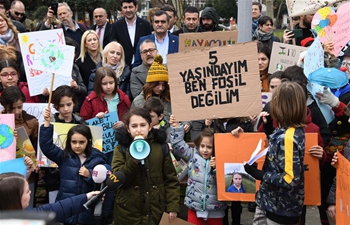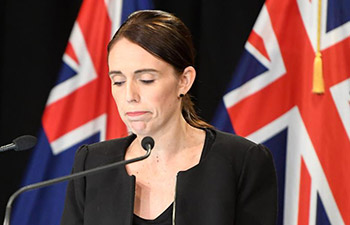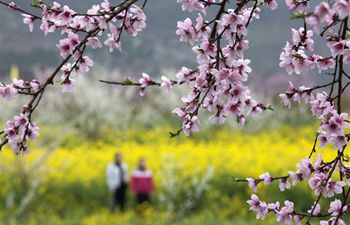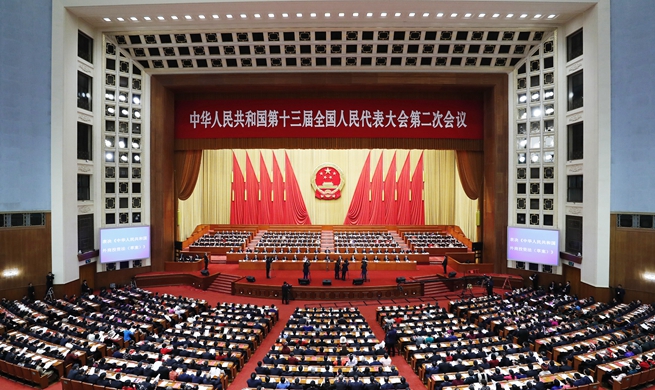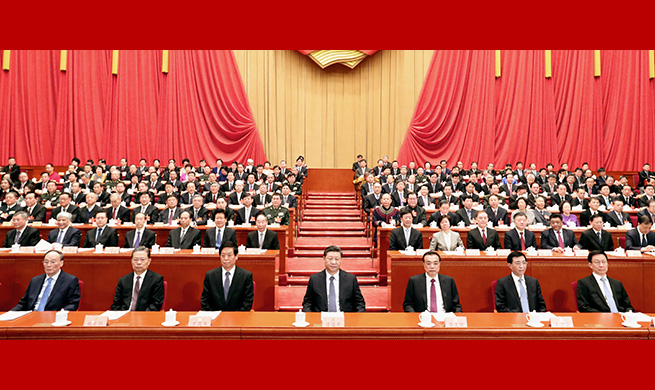by Peter Mertz
DENVER, the United States, March 15 (Xinhua) -- As millions of Americans feel the brunt of a powerful, late season storm, climate experts said the sudden blizzard was no fluke, but a sign of things to come.
"Blame climate change for the 'bomb cyclone,'" said Sonia Aggarwal, vice president of Energy Innovation, a Los Angeles-based energy policy think tank.
In 48 hours, the freak storm, called a "bomb cyclone," has affected some 100 million Americans, the U.S. National Weather Service (NWS) estimated Friday.
It has rumbled across roughly 5.18 million square km from the Rocky Mountains to the Mississippi River, and from the Mexican to Canadian borders.
On Friday, Iowa Governor Kim Reynolds signed an emergency disaster proclamation for funding to combat flooding in parts of the state caused by the "bomb cyclone."
"Some of the devastating flooding associated with this storm is due to the fact that heavy rain is falling on areas where there is snow on the ground," said Kristina Dahl, senior climate scientist of the Union of Concerned Scientists (UCS).
"Whether precipitation falls as rain or as snow is clearly linked to temperature, with rainfall being more likely in a warmer world," she told Xinhua.
BLAST FROM THE ROCKIES
Reynolds was the second governor behind Colorado's Jared Polis to declare a state of emergency from the unexpected climate bomb blast.
On Wednesday up to 1.2 meters of snow and 170-km-per-hour winds blasted Colorado, leaving thousands of motorists stranded and tens of thousands of people without power in Colorado and Texas.
Southern Colorado saw a staggering 114.3 centimeters of snow fall over 24 hours starting from Wednesday. Rescue crews scrambled nonstop using ski-resort Snowcat equipment to pull frantic motorists to safety, as thousands of cars were left on the shoulders of highways, local sheriff departments reported.
On Wednesday, a 100-vehicle accident was reported near the town of Wellington in Colorado, and a state trooper was killed trying to rescue a stranded motorist.
For more than two days, hundreds of airline travelers slept inside Colorado's Denver International Airport while the storm raged and clean-up operations ensued.
By Friday, the "bomb cyclone" was 1,183 km away, flooding roads in Iowa, Nebraska and Missouri and heading northeast into Minnesota toward Canada.
Fringes of the storm triggered a tornado in Kentucky, and tornado watches were issued throughout the region and as far east as Arkansas, Mississippi and Tennessee, the NWS reported Friday.
BOMB CYCLONE
Although the term "bomb cyclone" dates back to the year of 1980, it has only been used recently by meteorologists.
"A 'bomb cyclone' happens when there's a rapid pressure drop, with a decrease of at least 24 millibars (a measure of atmospheric pressure) over 24 hours known as "bombogenesis," according to the U.S. Weather Channel.
"This storm has dropped 33 millibars since Tuesday morning and continues to strengthen," it said.
"This type of storm behavior usually requires conditions that occur nearer to an ocean, and may be a first for Colorado," the NWS tweeted on Wednesday.
"The storm is expected to have an intense impact," it said.
In the eyes of Greg Carbin, chief of Forecast Operations for the National Oceanic and Atmospheric Administration, "this is a very epic cyclone," which could develop into the worst storm of its type in 35 or 40 years.
WHY?
"The intensity of this storm is due to a merging of two powerful jet stream disturbances that created a strong area of low pressure next to an area of high pressure that is feeding mild air and moisture from the Gulf of Mexico northward," Aggarwal said.
"Climate change is linked to unusual jet stream behavior and warming in the Gulf of Mexico, both of which can affect storm activity," she said.
"Modeling studies consistently suggest that the frequency and intensity of severe storms in the United States could increase as climate changes, particularly over the U.S. Midwest and Southern Great Plains during spring," she said.
Monika Barcikowska, a scientist at U.S. environmental watchdog titan the Environmental Defense League, concurred with Aggarwal.
"Scientists are currently investigating how the potential impacts of changes in atmospheric circulation patterns (specifically the weakening jet stream) associated with Arctic warming may influence mid-latitude cold snaps," said Barcikowska.
"We do know that here is a link between the warming Arctic and the weather patterns in the mid-latitudes," she said.
Besides, in the eyes of Dahl from the UCS, an organization with more than 100,000 members, "there is mounting evidence that climate change is influencing the pattern and position of the jet stream, and those changes could influence the development and path of storms."
All the scientists agreed that aberrant climate conditions, such as the hurricanes that have ravaged U.S. East Coast and Gulf of Mexico states in recent years, were the results of climate change.
